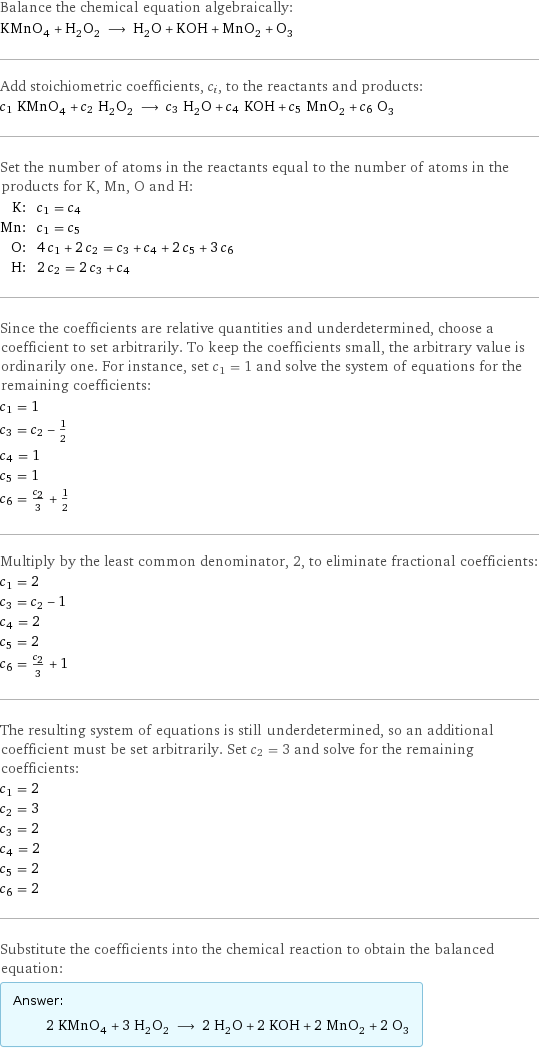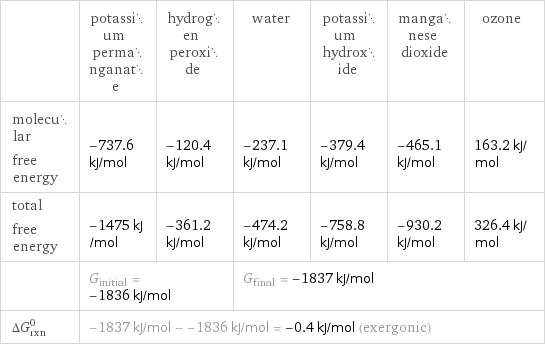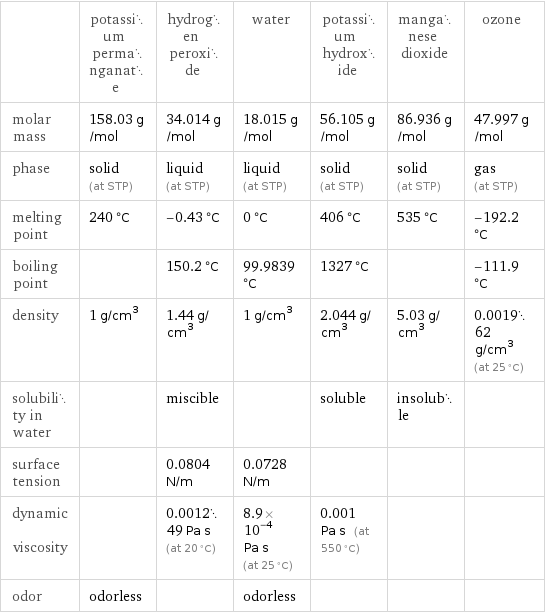Input interpretation

KMnO_4 potassium permanganate + H_2O_2 hydrogen peroxide ⟶ H_2O water + KOH potassium hydroxide + MnO_2 manganese dioxide + O_3 ozone
Balanced equation

Balance the chemical equation algebraically: KMnO_4 + H_2O_2 ⟶ H_2O + KOH + MnO_2 + O_3 Add stoichiometric coefficients, c_i, to the reactants and products: c_1 KMnO_4 + c_2 H_2O_2 ⟶ c_3 H_2O + c_4 KOH + c_5 MnO_2 + c_6 O_3 Set the number of atoms in the reactants equal to the number of atoms in the products for K, Mn, O and H: K: | c_1 = c_4 Mn: | c_1 = c_5 O: | 4 c_1 + 2 c_2 = c_3 + c_4 + 2 c_5 + 3 c_6 H: | 2 c_2 = 2 c_3 + c_4 Since the coefficients are relative quantities and underdetermined, choose a coefficient to set arbitrarily. To keep the coefficients small, the arbitrary value is ordinarily one. For instance, set c_1 = 1 and solve the system of equations for the remaining coefficients: c_1 = 1 c_3 = c_2 - 1/2 c_4 = 1 c_5 = 1 c_6 = c_2/3 + 1/2 Multiply by the least common denominator, 2, to eliminate fractional coefficients: c_1 = 2 c_3 = c_2 - 1 c_4 = 2 c_5 = 2 c_6 = c_2/3 + 1 The resulting system of equations is still underdetermined, so an additional coefficient must be set arbitrarily. Set c_2 = 3 and solve for the remaining coefficients: c_1 = 2 c_2 = 3 c_3 = 2 c_4 = 2 c_5 = 2 c_6 = 2 Substitute the coefficients into the chemical reaction to obtain the balanced equation: Answer: | | 2 KMnO_4 + 3 H_2O_2 ⟶ 2 H_2O + 2 KOH + 2 MnO_2 + 2 O_3
Structures

+ ⟶ + + +
Names

potassium permanganate + hydrogen peroxide ⟶ water + potassium hydroxide + manganese dioxide + ozone
Reaction thermodynamics
Gibbs free energy

| potassium permanganate | hydrogen peroxide | water | potassium hydroxide | manganese dioxide | ozone molecular free energy | -737.6 kJ/mol | -120.4 kJ/mol | -237.1 kJ/mol | -379.4 kJ/mol | -465.1 kJ/mol | 163.2 kJ/mol total free energy | -1475 kJ/mol | -361.2 kJ/mol | -474.2 kJ/mol | -758.8 kJ/mol | -930.2 kJ/mol | 326.4 kJ/mol | G_initial = -1836 kJ/mol | | G_final = -1837 kJ/mol | | | ΔG_rxn^0 | -1837 kJ/mol - -1836 kJ/mol = -0.4 kJ/mol (exergonic) | | | | |
Equilibrium constant
![Construct the equilibrium constant, K, expression for: KMnO_4 + H_2O_2 ⟶ H_2O + KOH + MnO_2 + O_3 Plan: • Balance the chemical equation. • Determine the stoichiometric numbers. • Assemble the activity expression for each chemical species. • Use the activity expressions to build the equilibrium constant expression. Write the balanced chemical equation: 2 KMnO_4 + 3 H_2O_2 ⟶ 2 H_2O + 2 KOH + 2 MnO_2 + 2 O_3 Assign stoichiometric numbers, ν_i, using the stoichiometric coefficients, c_i, from the balanced chemical equation in the following manner: ν_i = -c_i for reactants and ν_i = c_i for products: chemical species | c_i | ν_i KMnO_4 | 2 | -2 H_2O_2 | 3 | -3 H_2O | 2 | 2 KOH | 2 | 2 MnO_2 | 2 | 2 O_3 | 2 | 2 Assemble the activity expressions accounting for the state of matter and ν_i: chemical species | c_i | ν_i | activity expression KMnO_4 | 2 | -2 | ([KMnO4])^(-2) H_2O_2 | 3 | -3 | ([H2O2])^(-3) H_2O | 2 | 2 | ([H2O])^2 KOH | 2 | 2 | ([KOH])^2 MnO_2 | 2 | 2 | ([MnO2])^2 O_3 | 2 | 2 | ([O3])^2 The equilibrium constant symbol in the concentration basis is: K_c Mulitply the activity expressions to arrive at the K_c expression: Answer: | | K_c = ([KMnO4])^(-2) ([H2O2])^(-3) ([H2O])^2 ([KOH])^2 ([MnO2])^2 ([O3])^2 = (([H2O])^2 ([KOH])^2 ([MnO2])^2 ([O3])^2)/(([KMnO4])^2 ([H2O2])^3)](../image_source/fb9e529ab041009e849d8ee57382332c.png)
Construct the equilibrium constant, K, expression for: KMnO_4 + H_2O_2 ⟶ H_2O + KOH + MnO_2 + O_3 Plan: • Balance the chemical equation. • Determine the stoichiometric numbers. • Assemble the activity expression for each chemical species. • Use the activity expressions to build the equilibrium constant expression. Write the balanced chemical equation: 2 KMnO_4 + 3 H_2O_2 ⟶ 2 H_2O + 2 KOH + 2 MnO_2 + 2 O_3 Assign stoichiometric numbers, ν_i, using the stoichiometric coefficients, c_i, from the balanced chemical equation in the following manner: ν_i = -c_i for reactants and ν_i = c_i for products: chemical species | c_i | ν_i KMnO_4 | 2 | -2 H_2O_2 | 3 | -3 H_2O | 2 | 2 KOH | 2 | 2 MnO_2 | 2 | 2 O_3 | 2 | 2 Assemble the activity expressions accounting for the state of matter and ν_i: chemical species | c_i | ν_i | activity expression KMnO_4 | 2 | -2 | ([KMnO4])^(-2) H_2O_2 | 3 | -3 | ([H2O2])^(-3) H_2O | 2 | 2 | ([H2O])^2 KOH | 2 | 2 | ([KOH])^2 MnO_2 | 2 | 2 | ([MnO2])^2 O_3 | 2 | 2 | ([O3])^2 The equilibrium constant symbol in the concentration basis is: K_c Mulitply the activity expressions to arrive at the K_c expression: Answer: | | K_c = ([KMnO4])^(-2) ([H2O2])^(-3) ([H2O])^2 ([KOH])^2 ([MnO2])^2 ([O3])^2 = (([H2O])^2 ([KOH])^2 ([MnO2])^2 ([O3])^2)/(([KMnO4])^2 ([H2O2])^3)
Rate of reaction
![Construct the rate of reaction expression for: KMnO_4 + H_2O_2 ⟶ H_2O + KOH + MnO_2 + O_3 Plan: • Balance the chemical equation. • Determine the stoichiometric numbers. • Assemble the rate term for each chemical species. • Write the rate of reaction expression. Write the balanced chemical equation: 2 KMnO_4 + 3 H_2O_2 ⟶ 2 H_2O + 2 KOH + 2 MnO_2 + 2 O_3 Assign stoichiometric numbers, ν_i, using the stoichiometric coefficients, c_i, from the balanced chemical equation in the following manner: ν_i = -c_i for reactants and ν_i = c_i for products: chemical species | c_i | ν_i KMnO_4 | 2 | -2 H_2O_2 | 3 | -3 H_2O | 2 | 2 KOH | 2 | 2 MnO_2 | 2 | 2 O_3 | 2 | 2 The rate term for each chemical species, B_i, is 1/ν_i(Δ[B_i])/(Δt) where [B_i] is the amount concentration and t is time: chemical species | c_i | ν_i | rate term KMnO_4 | 2 | -2 | -1/2 (Δ[KMnO4])/(Δt) H_2O_2 | 3 | -3 | -1/3 (Δ[H2O2])/(Δt) H_2O | 2 | 2 | 1/2 (Δ[H2O])/(Δt) KOH | 2 | 2 | 1/2 (Δ[KOH])/(Δt) MnO_2 | 2 | 2 | 1/2 (Δ[MnO2])/(Δt) O_3 | 2 | 2 | 1/2 (Δ[O3])/(Δt) (for infinitesimal rate of change, replace Δ with d) Set the rate terms equal to each other to arrive at the rate expression: Answer: | | rate = -1/2 (Δ[KMnO4])/(Δt) = -1/3 (Δ[H2O2])/(Δt) = 1/2 (Δ[H2O])/(Δt) = 1/2 (Δ[KOH])/(Δt) = 1/2 (Δ[MnO2])/(Δt) = 1/2 (Δ[O3])/(Δt) (assuming constant volume and no accumulation of intermediates or side products)](../image_source/6d70f0677a5d69f16d18ac2f1ed5d754.png)
Construct the rate of reaction expression for: KMnO_4 + H_2O_2 ⟶ H_2O + KOH + MnO_2 + O_3 Plan: • Balance the chemical equation. • Determine the stoichiometric numbers. • Assemble the rate term for each chemical species. • Write the rate of reaction expression. Write the balanced chemical equation: 2 KMnO_4 + 3 H_2O_2 ⟶ 2 H_2O + 2 KOH + 2 MnO_2 + 2 O_3 Assign stoichiometric numbers, ν_i, using the stoichiometric coefficients, c_i, from the balanced chemical equation in the following manner: ν_i = -c_i for reactants and ν_i = c_i for products: chemical species | c_i | ν_i KMnO_4 | 2 | -2 H_2O_2 | 3 | -3 H_2O | 2 | 2 KOH | 2 | 2 MnO_2 | 2 | 2 O_3 | 2 | 2 The rate term for each chemical species, B_i, is 1/ν_i(Δ[B_i])/(Δt) where [B_i] is the amount concentration and t is time: chemical species | c_i | ν_i | rate term KMnO_4 | 2 | -2 | -1/2 (Δ[KMnO4])/(Δt) H_2O_2 | 3 | -3 | -1/3 (Δ[H2O2])/(Δt) H_2O | 2 | 2 | 1/2 (Δ[H2O])/(Δt) KOH | 2 | 2 | 1/2 (Δ[KOH])/(Δt) MnO_2 | 2 | 2 | 1/2 (Δ[MnO2])/(Δt) O_3 | 2 | 2 | 1/2 (Δ[O3])/(Δt) (for infinitesimal rate of change, replace Δ with d) Set the rate terms equal to each other to arrive at the rate expression: Answer: | | rate = -1/2 (Δ[KMnO4])/(Δt) = -1/3 (Δ[H2O2])/(Δt) = 1/2 (Δ[H2O])/(Δt) = 1/2 (Δ[KOH])/(Δt) = 1/2 (Δ[MnO2])/(Δt) = 1/2 (Δ[O3])/(Δt) (assuming constant volume and no accumulation of intermediates or side products)
Chemical names and formulas

| potassium permanganate | hydrogen peroxide | water | potassium hydroxide | manganese dioxide | ozone formula | KMnO_4 | H_2O_2 | H_2O | KOH | MnO_2 | O_3 Hill formula | KMnO_4 | H_2O_2 | H_2O | HKO | MnO_2 | O_3 name | potassium permanganate | hydrogen peroxide | water | potassium hydroxide | manganese dioxide | ozone IUPAC name | potassium permanganate | hydrogen peroxide | water | potassium hydroxide | dioxomanganese | ozone
Substance properties

| potassium permanganate | hydrogen peroxide | water | potassium hydroxide | manganese dioxide | ozone molar mass | 158.03 g/mol | 34.014 g/mol | 18.015 g/mol | 56.105 g/mol | 86.936 g/mol | 47.997 g/mol phase | solid (at STP) | liquid (at STP) | liquid (at STP) | solid (at STP) | solid (at STP) | gas (at STP) melting point | 240 °C | -0.43 °C | 0 °C | 406 °C | 535 °C | -192.2 °C boiling point | | 150.2 °C | 99.9839 °C | 1327 °C | | -111.9 °C density | 1 g/cm^3 | 1.44 g/cm^3 | 1 g/cm^3 | 2.044 g/cm^3 | 5.03 g/cm^3 | 0.001962 g/cm^3 (at 25 °C) solubility in water | | miscible | | soluble | insoluble | surface tension | | 0.0804 N/m | 0.0728 N/m | | | dynamic viscosity | | 0.001249 Pa s (at 20 °C) | 8.9×10^-4 Pa s (at 25 °C) | 0.001 Pa s (at 550 °C) | | odor | odorless | | odorless | | |
Units
